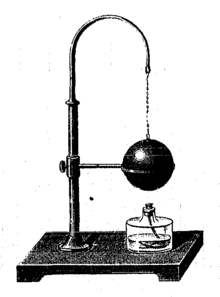Willem Jacob's Gravesande
Willem Jacob 's Gravesande (born September 26, 1688 in Herzogenbusch , † February 28, 1742 in Leiden ) was a Dutch astronomer , philosopher , physicist and mathematician .
Live and act
His father, Dirk Storm van 's Gravesande (1646-1716), was sheriff of the city of Herzogenbusch and administrator of the lands of Wilhelm III. , King of England, and later by William IV , Prince of Orange. His mother was Anna Louisa Blom (1653-1724). The couple had been married since July 11, 1681 and had a total of eight sons and one daughter. His maternal grandfather was Johannes Heurnius, professor at the University of Leiden.
At the age of sixteen, Willem Jacob 's Gravesande studied law at the University of Leiden and received his doctorate in 1707 with a dissertation on suicide.
In 1715 toured's Gravensande for the coronation of George I as a member of a delegation from the British capital London . During his subsequent year-long stay in London, he became a member of the Royal Society , where he made the acquaintance of Isaac Newton , John Theophilus Desaguliers , and the Scottish mathematician John Keill .
In 1717 's Gravesande became professor of astronomy and mathematics at the University of Leiden . The chairs for civil and military architecture and philosophy follow in 1730 and 1734. 1723/24 he was rector of the university .
A wheel invented by the German watchmaker and inventor Johann Bessler and presented to the public on June 6, 1712 in Gera , which supposedly turned without a drive and caused a sensation at the time, was inspected several times by 's Gravesande until 1722.
In 1720 he married Anna Savelaire, with whom he had two sons.
For the practical demonstration of his teaching, 's Gravesande designed a large number of devices and instruments, which were realized by the instrument maker Jan van Musschenbroek, brother of the physics professor Pieter van Musschenbroek .
'S Gravesandes' work had a strong influence on experimental physics in the eighteenth century. Some models of his instruments are in the Institute and Museum for the History of Science in Florence .
Willem Jacob 's Gravesande taught at the University of Leiden all his life. He turned down invitations from Tsar Peter I to the Imperial Academy of Sciences in Saint Petersburg and from Friedrich II of Prussia to the Berlin Academy.
An important contribution to mechanics was his experiment with two brass balls, which he let fall at different speeds onto a smooth, soft surface made of clay . 'S Gravesandes showed that, for example, a ball falling twice as fast creates a pit four times as deep, a ball falling three times as fast creates a pit nine times as deep, and so on. He communicated his results to Émilie du Châtelet . Both were in correspondence with one another.
Du Châtelet then corrected Newton's formula E = mv of the kinetic energy to E ∝ mv 2 , where E = mv stands for the kinetic energy (a factor of 1/2 is added later:) . The concept of kinetic energy was introduced by Émilie du Châtelet, based on the ideas of Gottfried Wilhelm Leibniz , as Vis Viva, Lebendige Kraft and the experiments of 's Gravesande. Like Leibniz, she represented the theory that the kinetic energy must be proportional to v². Isaac Newton , on the other hand, took the view that kinetic energy was proportional to speed. She recognized in the experiments of Willem Jacob 's Gravesande the confirmation of Leibniz' ideas. Up to this point in time, Newton's view was that the kinetic energy was proportional to the speed (see also acceleration ).
Instruments
Eponyms
In 2001 the asteroid (9682) Gravesande was named after him.
Fonts in German translation
- Use of the dark chamber for drawing , in: Sarah Kofman, Camera obscura. Von der Ideologie, edited and translated from French by Marco Gutjahr, Vienna / Berlin: Turia + Kant 2014, pp. 91–123.
Fonts
- Physices elementa mathematica, experimentis confirmata. 2 volumes (1720/21)
- Philosophiae Newtonianae institutiones, in usus academicos. (1723)
Web links
- Literature by and about Willem Jacob 's Gravesande in the catalog of the German National Library
- Website Institute and Museum for the History of Science (English)
Individual evidence
- ^ Albert van Helden: "Willem Jacob 's Gravesande, 1688-1742." In K. van Berkel; A. van Helden; L. Palm (Ed.): A History of Science in The Netherlands. Brill, Leiden: 1999, pp. 450-453
- ↑ Family genealogy
- ^ AR Hall: "'s Gravesande, Willem Jacob", in Dictionary of Scientific Biography, vol. V, New York 1972, pp. 509-11.
- ^ C. de Pater: "Experimental Physics" In Th. H. Leusingh (ed.): Leiden university in the seventeenth century, An exchange of learning, Leiden 1975, pp. 308–327.
- ↑ Minor Planet Circ. 42359
| personal data | |
|---|---|
| SURNAME | Gravesande, Willem Jacob 's |
| BRIEF DESCRIPTION | Dutch physicist, astronomer and mathematician |
| DATE OF BIRTH | September 26, 1688 |
| PLACE OF BIRTH | Herzogenbusch , Netherlands |
| DATE OF DEATH | February 28, 1742 |
| Place of death | Leiden , Netherlands |



